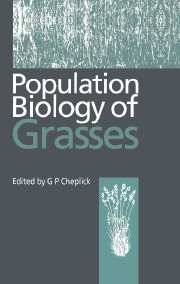Book contents
- Frontmatter
- Contents
- Contributors
- Preface
- Darwin revisited: approaches to the ecological study of grasses
- Part one Population variation and life history patterns
- Part two Ecological interactions
- Part three Population biology of specific groups
- 12 Population dynamics in the regeneration process of monocarpic dwarf bamboos, Sasa species
- 13 Population dynamics of perennial grasses in African savanna and grassland
- 14 A life cycle approach to the population ecology of two tropical grasses in Queensland, Australia
- Index
13 - Population dynamics of perennial grasses in African savanna and grassland
Published online by Cambridge University Press: 14 September 2009
- Frontmatter
- Contents
- Contributors
- Preface
- Darwin revisited: approaches to the ecological study of grasses
- Part one Population variation and life history patterns
- Part two Ecological interactions
- Part three Population biology of specific groups
- 12 Population dynamics in the regeneration process of monocarpic dwarf bamboos, Sasa species
- 13 Population dynamics of perennial grasses in African savanna and grassland
- 14 A life cycle approach to the population ecology of two tropical grasses in Queensland, Australia
- Index
Summary
Introduction
Perennial grasses are a predominant component of the savanna and grassland biomes of sub-Saharan Africa. Savannas constitute more than half of the land surface area of this region. True grasslands are less widespread, occurring mainly in mid-latitude or high-altitude regions or as smaller fragments depending on local edaphic or climatic conditions (O'Connor & Bredenkamp, 1997). The terms grassland and savanna disguise the variation in climate and environmental conditions associated with each. Perennial grassland (true or savanna) can be encountered in regions receiving rainfall of as little as 150 mm yr−1 or as much as 1200 mm yr−1; they may occur in areas which experience snowfall in winter or areas of tropical climate; they may be found on leached, dystrophic, sandy soils or on extremely fertile volcanic, clay soils; they may be burned on an annual basis or have 20 or more years pass without experiencing a fire; most are associated with the remarkable adaptive radiation of African ungulates whilst others are barely subject to herbivory by large mammals; they are at the heart of a pastoral enterprise which directly supports a greater human population than any other pastoral enterprise in the world.
The variation in climate and environment is matched by a diversity of species and growth forms. In southern Africa alone there are 723 species of perennial grass (Gibbs Russell et al., 1990). A community may contain caespitose, stoloniferous or rhizomatous growth forms; swards may be a 5– cm-high grazing lawn or 3 m tall when flowering; swards may consist of scattered individuals or have a closed canopy.
- Type
- Chapter
- Information
- Population Biology of Grasses , pp. 333 - 365Publisher: Cambridge University PressPrint publication year: 1998
- 14
- Cited by



